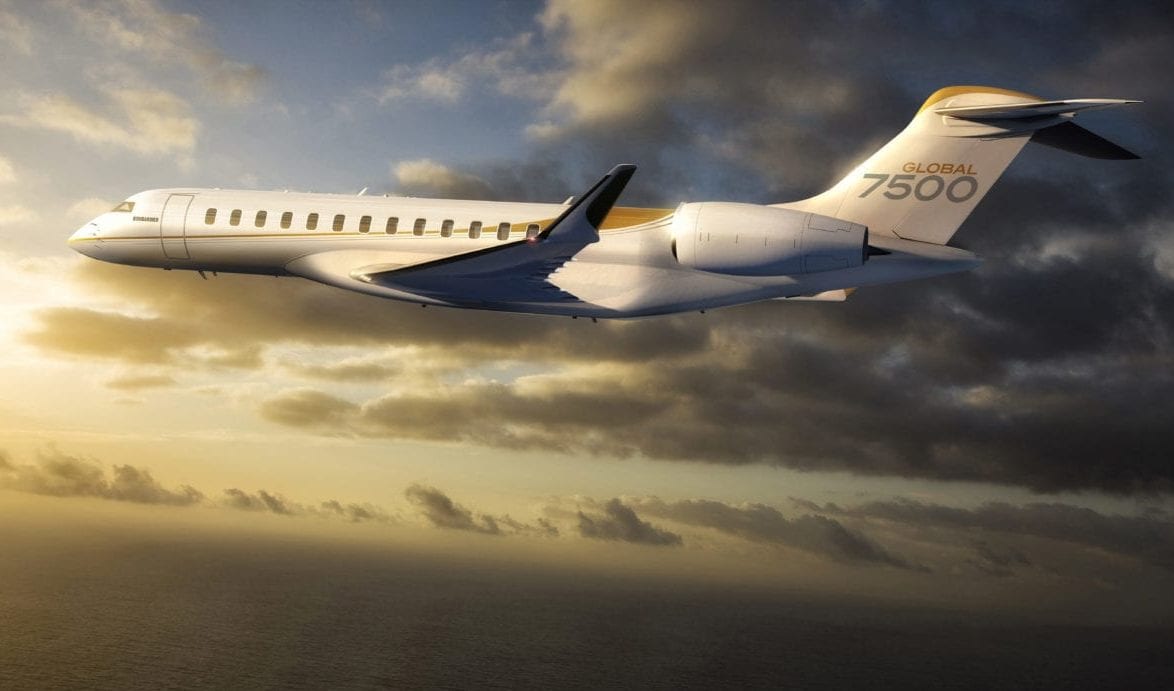
An image of the newly released Bombardier Global 7500 business jet. (Bombardier)
For the first time in five years, Bombardier finished the year with a profit, earning a net income of $318 million in 2018 as the company looks to complete its turnaround.
Total revenues of $16.2 billion for the year were dragged down by losses in the commercial aircraft segment, but Bombardier saw modest growth in its larger business division, where it launched its new flagship Global 7500 jet, and significant growth in the newer aerostructures and engineering services business. Bombardier’s largest segment, land-focused rail transportation, saw small growth despite struggles meeting deadlines and quality targets.
“2018 was a year of solid progress,” said Alain Bellemare, Bombardier president and CEO. “We continued to strengthen our business and set a strong foundation for growth.
“As we begin the fourth year of our turnaround journey, Bombardier is a much stronger company. Our major program risks are retired, our heavy investment cycle is behind us and our franchises are well positioned for growth. For 2019, we are focused on flawless execution of our rail projects, the ramp-up of the Global 7500 and entry-into-service of the Global 5500 and Global 6500.”
While the totals aren’t overwhelming, Bombardier’s stocks have been rising because the company significantly outperformed analyst expectations. Bombardier finished the year with a net income of $0.05 per share compared to the $0.02 per share expected by Thomas Reuters, and the company’s billion-dollar earnings before interest and taxes represented a 235 percent increase over last year’s $299 million.
Commercial aircraft
Returning its struggling commercial aircraft segment to profitability has been a goal for Bombardier for some time. 2018’s $157 million losses might have looked more like 2017’s losses of $381 million if not for the company selling off 69 percent of its failing C-Series and control of the jet to Airbus to be renamed the A220.
As a result of the restructuring, revenues in the division decreased by 24 percent from $2.3 to $1.8 billion, with Bombardier selling 35 aircraft to 2017’s total of 56. But, its book-to-bill ratio has gotten into the positive (0.3), its backlog has increased to 97 units and the tie-up with Airbus bodes well for the Canadian company’s future.

The A220-300, the rebranded Bombardier C-Series. (Airbus)
The Global 7500, which is Bombardier’s largest, longest-range jet, debuted in December. The company expects to sell close to 60 of the $70-plus million dollar luxury jets over the next two years and then ramp up production.
Business
For 2018, the business jet segment saw small gains across the board: a 1 percent year-over-year (YOY) revenue increase, from a bit over $4.9 to just under $5 billion; a 9 percent increase in before-taxes earnings, from $394 to $430 million; and a 4 percent YOY increase in the stated value of Bombardier’s business jet order backlog, from $13.8 to $14.3 billion.
Bombardier expects to release the Global 6500 and 5500 in 2019 and the 8000, a variant of the new 7500, is in the works. These higher-cost $50-to-$75 billion jets help buoy backlog value for the manufacturer.
Aerostructure and engineering services
The company’s aerostructure and engineering services division is smaller, seeing just under $2 billion in 2018 revenue, but it is growing quickly; that represents a 21 percent increase over 2017’s $1.6 billion. Earnings before interest and taxes in the group have nearly doubled, from $81 million to $146 million, an 80 percent YOY increase.
The growth for the segment is largely due to work supporting the Airbus A220 — the former Bombardier C-Series — and the Global 7500. On one hand, that is moving work from one pocket to the other rather than winning contracts outright, but it also represents getting in on the ground floor of two large projects that should provide sustainable growth for Bombardier’s engineering services group. It also indicates an interest in the same sort of vertical integration that Boeing has been chasing recently, on a smaller scale.
Transportation
Bombardier’s transportation group doesn’t deal in aerospace, but it is the company’s largest group, so its success plays a big role in the company’s fortunes. For some time, it has been struggling to meet timelines, which Bellemare acknowledges is “creating disappointment,” but he denied that there is a “systemic issue here.” To help curb the issues, Bombardier installed a new president of its transportation segment, Danny DiPerna in 2018.
Despite the struggles, transportation saw 4 percent YOY revenue growth, up to $8.9 billion, and it made $774 million in earnings before interest or taxes. However, its book-to-bill ratio, order intake, and the value of its backlog all dropped some, with the latter finishing at $34.5 billion, down 2 percent from last year’s $35.1 billion.
With the Global 7500 being delivered and more high-end business jets set to debut; its hands washed of the C-Series albatross; and a new president running its rail group, the next year or two will be crucial to see if Bombardier can keep its momentum up and turn from a slightly profitable company to one that thrives.